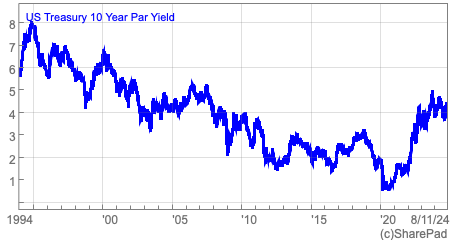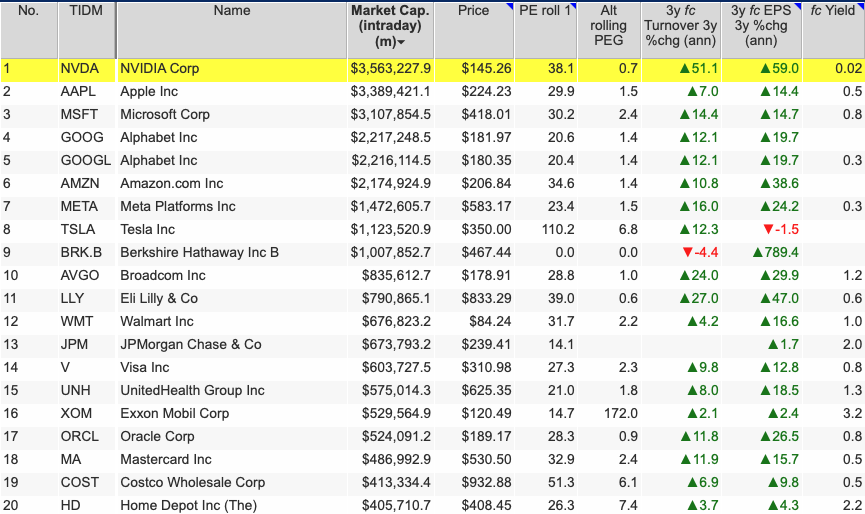
The Trump Trade excites equity investors
Last week was a truly pivotal week for stock markets, with US equities storming ahead. In this weeks Big Picture column we dig a little deeper into the trends revealed over the last week since Trump was (re) elected. Yet again UK equities underperformed but there were some fascinating moves in investment trust land.
By
David Stevenson
14 Nov, 2024
This week, I’m going to break with the regular schedule of charting progress (or otherwise) in our Doceo Model investment trust portfolios and switch instead to the big topic on everyone’s minds: the Trump win. We’ve seen a version of what’s been called the Trump Trade playing out for a few weeks now, even before the resounding electoral win.
In simple terms, this trade is bullish for most US equities (more tax cuts), bearish for US Treasury stock (more debt issuance, higher yields), and super bullish for bitcoin (Trump has heartily embraced the crypto tech bros). As for the rest of the investment world, the Trump trade is mainly silent. It’s bad news for most emerging markets and their currencies, good news on balance for many commodities, and neutral overall for gold (assuming Trump stops all the wars, which is a big ask).
Well, as you’d expect, most of those trades played out last week as the US election results came in – worries about post-election legal fights faded away, and Trump and the Republicans stormed ahead to win not only the presidency but also the Senate and, probably, the House of Representatives. The reaction from equity investors was almost instant:
The NASDAQ 100 index rose 5.78% last week, while the DJIA was up 4,95% (the S&P 500 was up 4.29%)
US stocks added $1.62 trillion in value on Wednesday (last week), marking the largest-ever post-election gain and the 5th largest single-day gain in history.
The S&P 500 is now up 25% in 2024, the best start to a year since 1997 and 12th best in history.
According to Rahul Bhushan “US households’ stock allocation has reached 49%. Americans have never held more stocks in modern history.” According to Carson Research, the S&P 500 has gained an average of +15.2% in the year, following 9 of the last 10 elections, adding optimism for further upside in 2025.
In terms of individual US stocks Tesla pushed past the $1 trillion market value, up 12.3% over the week, but the real winners were security plays such as Palantir up 41% over the week) and Axon Enterprise (up 39%). Other notable winners included EPAM Systems, Trimble (defence again), and even poor old Intel (up 16%).
Even Chinese stocks did all right – the CSI 300 was up 4% as local investors anticipated local policy initiatives to combat Trump tariffs
Japanese stocks in the Nikkei 225 rose 3.8%
Overall the FTSE All World index was up 3.36% over the last week
There were marginal gains in Europe for French equities (the CAC 40 was up 0.7%), German equities (the FAX was up 1.61%) and the Swiss Market was up 0.27%.
The US dollar gained which might constrain equity enthusiasts over time
Brazil is one of the few EM nations that could benefit from potential trade wars through China’s retaliation.
Bitcoin set 2 milestones, crossing $75,000 during the week, and reaching $80,000 over the weekend, bringing its YTD gain to ~90%
Over in commodities land, very few gained over the week, except soybean futures (up 3%), coffee (up 3%), cotton (up 1.5%), coal and steel.
How about the losers?
Since mid-September, the yield on the 10-year Treasury bond has climbed by 70 bps to 4.305%
most EM currencies lost with the Mexican peso and Asian manufacturers’ currencies affected most.
In the commodities space, gold has slipped by 1.84% over the week but silver was the biggest loser (down just under 5%) only bested by platinum down 7.4%.
What about the UK? UK equities fell behind, again. The FTSE ALL Share index was down marginally over the week, as was the FTSE 100 (both under 1%). By contrast, the FTSE 250 did rally 1.19%. Looking at individual UK large-cap stocks, the biggest gainers have been Wise (up 17% over the week), BAe Systems (up 11.9%), and IAG, up 10%. In terms of individual users, that list is topped by ITV (down 14.5% over the week in non-US election news), Ocado (down 3.3%) and Burberry (down 2.69%).
Let’s stop and ponder prospects for the UK market more generally for one moment. I would maintain that the UK economy post-budget is in calmer waters, despite all the howls of protest from big business (over the NI and minimum wage changes) and farmers.
National economic growth should pick up as extra spending kicks in, and British businesses should benefit from the faster economic growth in the US, which proponents of the Trump trade promise. As US equities grind ever higher, more and more value types might be tempted to look at decently valued alternative markets with decent growth prospects, such as the UK market – we might even benefit from the growing concerns about the Eurozone economy. Another positive might be an uptick in M&A activity as liquidity conditions improve and more deal making emerges.
However, there is an evident risk: those Trump tariffs specifically and the Trump administration’s views of the Labour government. The UK is an open economy and not in a big trade block like the EU, which makes us especially vulnerable to general tariffs imposed by Trump. And if a China-US tariff war does break out, the Eurozone will probably be forced to defend its markets with its own tariffs, which could again hit the UK hard. At the political level, I’d also be worried by the evident hostility from many senior Republicans towards parts of the Labour government. Being one of the most left-wing administrations in the G7 is probably not an attribute worth shouting about in a new Trump-led world order. Thus, the political risks are growing even as macroeconomic prospects brighten.














